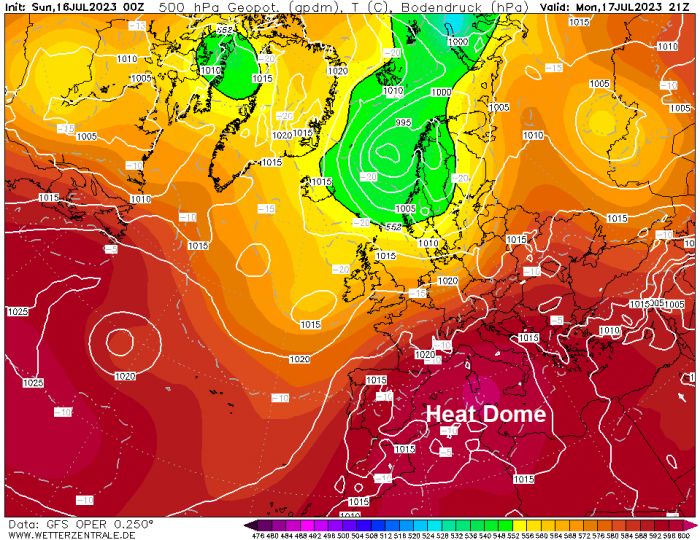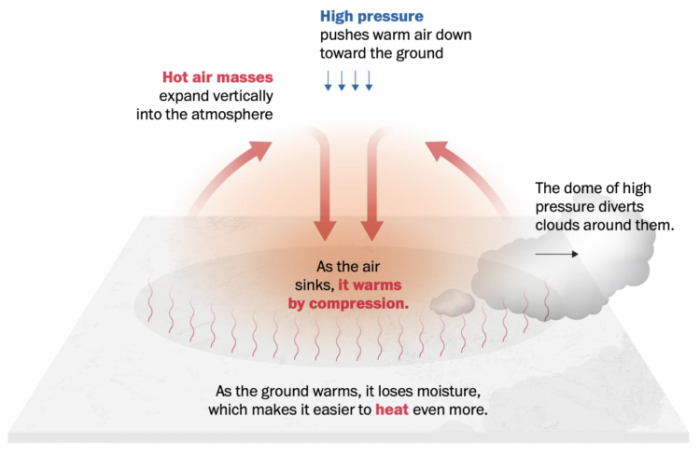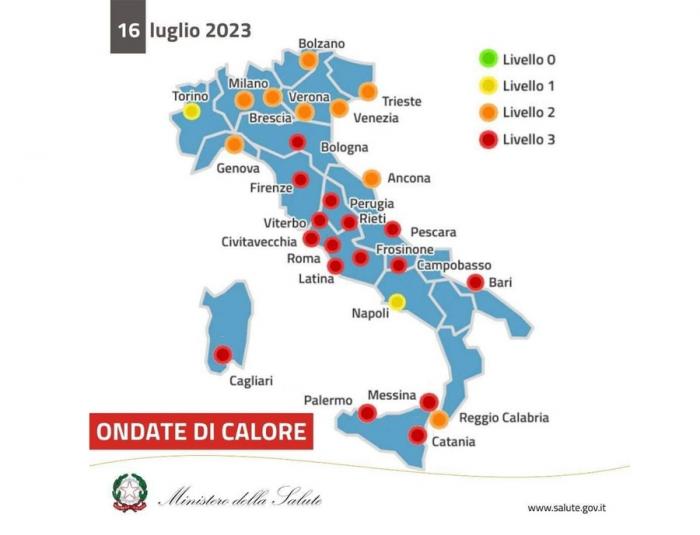
It’s high summer, schools are on holiday in Scotland and soon to be in England and Wales, so many will have plans to go abroad to continental Europe. But holidaymakers should be aware of very high temperatures forecast next week across popular summer getaway spots in Spain, Italy and Greece. Temperatures are forecast to reach in excess of 40C across southern Spain, central and southern Italy (including Sardinia and Sicily) and parts of Greece. Some spots could reach 45-46C. The (provisional) European highest temperature on record is 48.8C (120F) which was reached in Sicily on 11th August 2021.
The heatwave gripping southern Europe also has an unofficial name: Cerberus. After the mythical monster, Cerberus, who was said to guard the gates of Hell.
The extreme heat is likely a result of a stable blocking high pressure system over the Mediterranean and an unseasonably deep upper trough over the far NE Atlantic combining to pull very hot air out of north Africa, where temperatures have been reaching 45-50C for days, across southern Europe.

500 hPa heights show a ‘heat dome’ stretching from NW Africa northeastwards across southern Europe, the heat dome is stable due an upper-level ridge creating subsidence from aloft and high pressure at the surface, meaning there is little mixing out of the hot airmass originating from NW Africa, so the heat is trapped and so temperatures keeping getting hotter under clear skies that occur with subsiding air. One can think of a heat dome as a pot with a lid on with water that is warmed up but the heat can’t escape upwards so it just gets hotter and hotter.
Diagram explaining a Heat Dome

Such blocking high pressure systems and associated heat domes building across parts of Europe from NW Africa, bringing extreme heat, are becoming increasingly common in recent years and very likely linked to climate change. The UK, so far this summer, has escaped this extreme heat which has built recently, because a dip in the jet stream across NW Europe has kept the UK under the influence of low pressure – which has drawn cooler more temperate air off the Atlantic. But last July we did have a brief visit of extreme heat, with 40C reached for the first time since records began. This was because a cut-off low to the west of Europe pulled a heat dome north from NW Africa, which was extremely hot last summer too, across western Europe to the UK.
Peak temperatures – which are around 10 to 15°C higher than average – could reach the mid-40 degrees Celsius in parts of southern Europe. Unusually high sea surface temperatures are also occurring across the region, with surface temperatures exceeding 30C (86F) in some parts of the Mediterranean, several degrees above average., which will exacerbate the effects of the heat over surrounding land areas.
From Monday, temperatures are forecast to climb into the low to mid-40 °C across parts of Spain and southern Portugal, south-central Italy, and later over the south of Balkans, Greece in Particular.


The Italian government has issued a Red Alert for 16 cities across the country, including Rome, Bologna and Florence.

It has warned people to avoid direct sunlight between 11h00 and 18h00 and to take particular care of the elderly and the vulnerable. Forecasters have told Italians to prepare for “the most intense heatwave of the summer and also one of the most intense of all time”.
The islands of Sicily and Sardinia could experience temperatures as high as 48C (118F), potentially equalling or exceeding the hottest temperatures ever recorded in Europe. Beach goers in Sardinia yesterday were using a cave to shelter from the sun.
In Greece, temperatures reached 39C in Athens yesterday, and parts of the country could see highs as much as 44C today. The Acropolis in Athens, Greece’s top tourist attraction, closed during the hottest hours yesterday and may well close again today to protect workers and visitors as the country wilts under an extreme heatwave.
With the hot and dry conditions, there are increased concerns about wildfires, especially if high winds develop to fan and thus spread fires quickly. Greece, in particular, has experienced major wildfires in previous heatwaves. A forest fire on the Spanish island of La Palma forced the evacuation of hundreds of people.
But it’s not just southern Europe that’s seeing extreme heat at the moment. Parts of eastern Japan are expected to reach 38 to 39C (100 to 102F) on Sunday and Monday, with the Japanese meteorological agency warning temperatures could hit or exceed previous records. Meanwhile, a heat dome stretching from California to Texas is bringing extreme heat to southwestern parts of the USA. Locations including Phoenix in Arizona and Las Vegas in Nevada could flirt with all-time record highs. Death Valley, 250 miles northeast of Los Angeles in California, could approach 54C (130 F). Phoenix has experienced 15 days in a row with high temperatures ranging from 110 to 118F. China has been experiencing extreme heat too, with Sanbao in Xinjiang Province reaching 51.7C earlier today, which beats the previous Chinese national record by a full 1C!
Image credit: Weather.com
The heatwaves come after the EU’s climate monitoring service said the world saw its hottest June on record last month.
The impacts on humans, animals and the environment from prolonged heatwaves and the heightened risk of wildfires emphasise the urgent need to address climate change.
Loading recent activity...